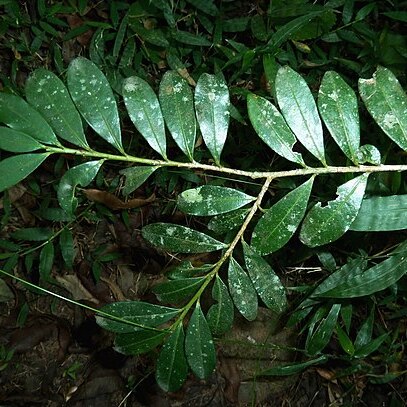Leaves petiolate; lamina (1·5) 2–12·5 (15) × (0·6) 1–4·5 (5) cm., varying from oblanceolate or rhombic (rarely obovate) to elliptic (rarely sub-circular), rounded or shortly acuminate towards the apex but always ± shallowly emarginate at the tip, narrowly to broadly cuneate (rarely rounded or truncate) at the base, coriaceous, bright to dark green or bluish-green and shining above, paler green or pale reddish-brown below, with midrib and ± loosely reticulate venation prominent on both sides; petiole 1·5–6 mm. long, rather slender, grooved above; stipules completely united, 1–2 mm. long, broadly triangular, acute, with entire membranous margin, persistent.
Tree or shrub, 1.5-9.0(18.0) m high, branchlets flattened towards tip. Leaves alternate, elliptic to oblanceolate, up to 125 x 45 mm, entire, coriaceous, glabrous, glossy, dark green above, paler green below, venation prominent, base cuneate, apex emarginate; petioles ± 6 mm long; stipules intrapetiolar. Flowers axillary, solitary or in fascicles of 2-8, small, pedicellate, white, scented. Flowering time Sept.-Dec. Fruit a small, 1-seeded drupe, ampullaceous (flask-shaped), up to 14 mm long, with calyx and filaments persisting at base, bright red, edible.
A shrub or small tree. It grows 6 m tall. It can be 25 m tall. The bark is dark grey. It has cracks along it. The leaves are alternate and broadly sword shaped. The leaves are 2-13 cm long by 1-5 cm wide. The leaves are held in one plane and the ends of the branches are flattened. It has sweet-scented white flowers. The flowers are in small clusters and in the axils of leaves. They are white to cream. The fruit are red berries. They are fleshy. They are 10-13 mm long.
Shrub or small tree (1) 1·5–9 m. high, occasionally taller (up to 18 m.), evergreen, glabrous; branches rather stout, somewhat flattened and with raised lines decurrent from the petiole-bases when young, soon terete, pale grey or grey-brown, almost smooth; bark vertically fissured, dark grey or grey-brown, sometimes pink-tinged.
Short-styled flowers: stamens equal, 4 mm. long; stamen-cup equal to the sepals, usually with 10-denticulate margin; ovary c. 1·5 mm. long, slightly longer than stamen-cup, obovoid; styles 3–1·5 mm. long, free.
Straggling shrub, up to 2 m high. Leaves oblanceolate to elliptic, usually 30-50 mm long, rather stiffly textured and hard, venation prominent, apex emarginate. Fruit ellipsoidal, fleshy, red. Flowers white.
Flowers solitary or in fascicles of 2–8 in the leaf-axils, usually borne in clusters on stem regions with short internodes; pedicels 5–14 mm. long, rather slender, angular.
Long-styled flowers: stamens unequal, the antisepalous 1·75 mm. and antipetalous 3·5 mm. long; stamen-cup as above; ovary as above; styles 3, 3–3·5 mm. long, free.
Petals white, c. 4 mm. long, oblong, rounded at the apex, shortly unguiculate; ligule 1–1·5 mm. long, shortly fimbriate, inserted 1/4 of the length above the base.
Drupe 8–12 mm. long, bright red, ampullaceous at first but occasionally becoming broadly ellipsoid.
Sepals c. 1 mm. long, triangular, acute, united for about 1/4 of their length.
A glabrous shrub or small tree
Flowers white, fragrant
Fruit red.


